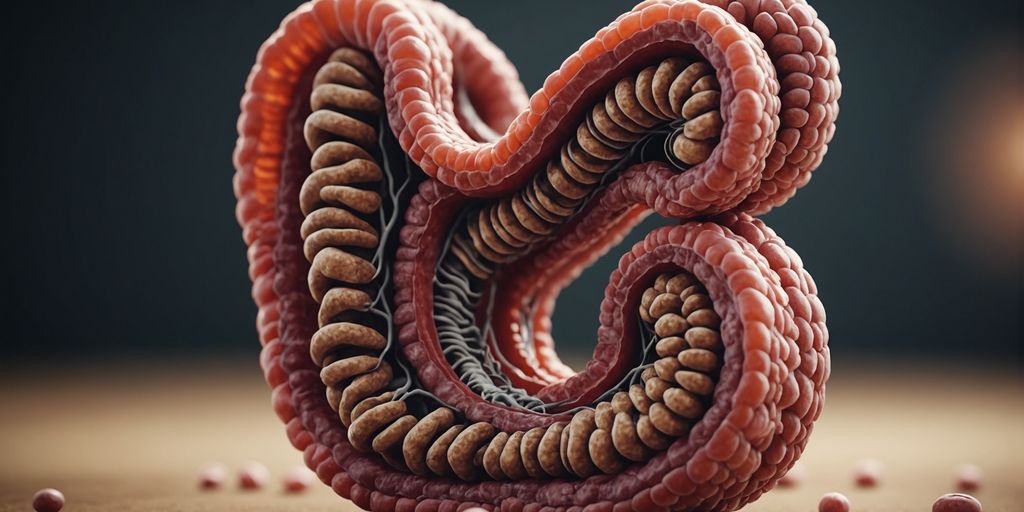A bowel obstruction happens when something blocks your intestines, either partially or completely. This blockage can occur in either the small or large intestine, leading to severe symptoms like stomach pain, bloating, and the inability to pass gas or stool. Immediate medical attention is crucial because untreated bowel obstructions can result in life-threatening complications.
Key Takeaways
- A bowel obstruction can block either the small or large intestine, causing severe symptoms like pain, bloating, and inability to pass gas or stool.
- There are different types of bowel obstructions, including small bowel obstruction, large bowel obstruction, and pseudo-obstruction.
- Causes of bowel obstruction can be mechanical, like tumors or scar tissue, or nonmechanical, like nerve or muscle problems.
- Diagnosis usually involves a medical history review, physical exam, and imaging tests like X-rays or CT scans.
- Treatment options range from non-surgical methods like medication and observation to surgical interventions in severe cases.
Understanding Bowel Obstruction
Definition and Overview
A bowel obstruction is a serious condition where something blocks either your large or small intestine. This blockage can be partial or complete, making it hard or impossible to pass stool or gas. When your digestive system is blocked, it can cause severe pain and swelling in your belly.
Differences Between Bowel Obstruction and Fecal Impaction
Though they share similar symptoms, bowel obstruction and fecal impaction are not the same. Fecal impaction happens when a large, hard mass of stool gets stuck in your digestive tract. In contrast, bowel obstruction is when something other than hard stool blocks your intestine.
Common Symptoms
The symptoms of a bowel obstruction can vary but often include:
- Severe belly pain and cramps
- Swollen belly
- Inability to pass gas or stool
- Nausea and vomiting
If you experience these symptoms, it’s important to seek medical help immediately.
Types of Bowel Obstruction
Bowel obstructions can be classified based on the location and nature of the blockage. Understanding these types is crucial for proper diagnosis and treatment.
Small Bowel Obstruction
Small bowel obstructions are the most common, accounting for about 80% of all cases. They occur in the small intestine and can prevent digested food from reaching the large intestine. This type of obstruction can be life-threatening if not treated promptly.
Large Bowel Obstruction
Large bowel obstructions occur in the large intestine and can slow or stop the passage of stool out of the body. These obstructions can cause severe complications if not addressed quickly.
Pseudo-obstruction
A pseudo-obstruction mimics the symptoms of a bowel obstruction but without an actual blockage. This condition can be caused by problems with the gastrointestinal muscles or nerves, and sometimes by medications like opioids.
Recognizing the type of bowel obstruction is essential for effective treatment and can significantly impact the patient’s outcome.
Causes and Risk Factors
Mechanical Obstructions
Mechanical obstructions are physical barriers that block the bowel. These include:
- Adhesions: Bands of scar tissue from previous surgeries.
- Hernias: When a part of the intestine pushes through a weak spot in the abdominal wall.
- Tumors: Cancerous growths that can block the intestines.
- Intussusception: A condition where one part of the intestine slides into another, like a telescope.
- Volvulus: Twisting of the intestine, which can cut off blood flow.
- Foreign objects: Items that are swallowed and cannot be digested.
- Gallstones: Rarely, these can block the intestines.
- Inflammatory bowel disease (IBD): Conditions like Crohn’s disease that cause swelling and scarring.
Nonmechanical Obstructions
Nonmechanical obstructions occur when the intestines stop moving properly. Causes include:
- Paralytic ileus: When muscles or nerves in the intestines don’t work correctly.
- Infections: Severe infections can disrupt normal bowel function.
- Medications: Certain drugs, like opioids, can slow down the intestines.
- Muscle and nerve disorders: Conditions like Parkinson’s disease.
- Electrolyte imbalances: Low levels of potassium or calcium.
- Diabetes: High blood sugar can affect bowel movements.
- Hypothyroidism: An underactive thyroid gland.
- Surgery: Operations on the abdomen or pelvis can lead to nonmechanical obstructions.
Risk Factors
Certain conditions and events can increase the risk of bowel obstruction:
- Previous abdominal or pelvic surgery: This can lead to adhesions.
- Crohn’s disease: Can cause the walls of the intestines to thicken.
- Cancer: Especially in the abdomen.
- Radiation therapy: Can cause scarring in the intestines.
Important: If you have any of these risk factors, it’s crucial to monitor your health and consult a doctor if you experience symptoms like colicky abdominal pain, nausea, or vomiting.
Diagnosis of Bowel Obstruction
Medical History and Physical Examination
When diagnosing a bowel obstruction, doctors start by asking about your medical history. They will inquire if you’ve had any previous abdominal surgeries, cancer, or if you’ve been constipated. A physical exam follows, where the doctor checks if your belly is swollen or if they can feel a lump. They might also use a stethoscope to listen for bowel sounds that indicate an obstruction.
Blood Tests and Imaging
Blood tests are essential to look for signs of dehydration or infection. These tests often include a complete blood count and electrolyte analysis. Imaging tests are crucial for confirming a diagnosis. Common imaging tests include:
- Abdominal X-ray: This can show the location of the blockage and if there are signs of a rupture or dead area in your intestine.
- CT scan: Provides detailed cross-section pictures of your bowel, offering more precise information than an X-ray.
- Barium enema or air enema: These tests involve inserting air or a liquid containing barium into your rectum to create clearer images. For children, these enemas can sometimes correct the blockage.
- Ultrasound: Often used for children, this test uses high-frequency sound waves to create images of the intestine.
Differential Diagnosis
Doctors must rule out other conditions that might mimic bowel obstruction symptoms. This process is called differential diagnosis. Conditions like fecal impaction, Crohn’s disease, and diverticulitis can present similar symptoms. Therefore, a thorough examination and multiple tests are often necessary to ensure an accurate diagnosis.
Diagnosing a bowel obstruction quickly is crucial because it can be a medical emergency. Immediate and accurate diagnosis helps in planning the right treatment and avoiding complications.
Treatment Options
Non-surgical Treatments
For partial bowel obstructions, doctors often start with non-surgical treatments. These can include:
- Bowel rest: This involves not eating or drinking for a while to let the bowel heal.
- Nasogastric tube: A tube is inserted through the nose into the stomach to remove fluids and gas, which can relieve symptoms.
- Medications: Over-the-counter laxatives and fiber supplements, such as Metamucil (psyllium) or Citrucel (methylcellulose), can help move things along.
Surgical Interventions
If non-surgical treatments don’t work or if the obstruction is complete, surgery may be needed. Surgical options include:
- Removing the blockage: The surgeon removes the part of the bowel that is blocked.
- Stent placement: A tube is placed in the bowel to keep it open.
- Colostomy or ileostomy: If the bowel can’t be reconnected, an opening is made in the abdomen to allow waste to exit into a bag.
Medications and Supportive Care
Medications can help manage symptoms and support recovery. These may include:
- Pain relievers: To manage discomfort.
- Antibiotics: If there’s an infection.
- IV fluids: To keep you hydrated and maintain electrolyte balance.
Deciding on the right treatment can be tough. It’s important to discuss options with your doctor and loved ones to make the best choice for your situation.
Complications of Bowel Obstruction
Perforation and Infection
When a bowel obstruction occurs, fluids, gases, and digestive juices build up behind the blockage. This can create intense pressure, causing the intestine to tear, or perforate. If the contents leak out, it can lead to a dangerous abdominal infection called peritonitis and a life-threatening systemic infection known as sepsis.
Strangulation and Tissue Death
Strangulation happens when the obstruction cuts off the blood supply to parts of the intestine. Without enough blood, the tissue can die, leading to gangrene. This condition is extremely serious and can result in severe infection and even death.
Long-term Complications
- Short Bowel Syndrome: Damage to the intestine can prevent the body from absorbing enough nutrients from food.
- Abdominal Abscesses: Pockets of pus and infected fluid can form inside the abdomen.
- Bowel Paralysis: The bowel may stop moving properly, leading to further complications.
- Nerve Damage: Surgery or prolonged obstruction can damage nerves in the bowel.
- Wound Reopening: Surgical wounds may reopen, causing additional health issues.
Prompt treatment is crucial to prevent these severe complications. If you suspect a bowel obstruction, seek medical attention immediately.
Preventing Bowel Obstruction
Dietary Changes
Simple changes to your diet can help prevent bowel obstructions. Eating smaller meals throughout the day and chewing food well can make digestion easier. Drinking plenty of water is also crucial to stay hydrated. If you’re at risk, your doctor might suggest avoiding high-fiber foods. Here’s a table of foods to consider:
| Category | Examples |
|---|---|
| Carbohydrates | White bread, white rice, white pasta, white flour, cornflour, low-fiber cereals |
| Fruit | Canned peaches, pears, melon, peeled apples, fruit juice (not orange juice) |
| Vegetables | Potatoes (no skin), well-cooked squash, carrots, courgette, asparagus, beetroot |
| Protein | All meat and fish, eggs |
| Dairy | Milk, cheese, yogurt (without fruit) |
Lifestyle Modifications
Regular exercise can help promote healthy bowel movements and reduce the risk of constipation. Aim to exercise regularly to keep your digestive system active. Additionally, avoid smoking and limit alcohol consumption, as these can negatively impact your digestive health.
Monitoring and Regular Check-ups
Regular check-ups with your doctor can help catch any potential issues early. If you have a history of bowel obstructions or related conditions, it’s important to monitor your symptoms closely. Early detection and treatment can prevent complications.
Making small changes in your daily routine can significantly lower the risk of bowel obstructions. Stay active, eat wisely, and keep up with medical appointments to maintain a healthy digestive system.
Conclusion
Bowel obstruction is a serious condition that requires prompt medical attention. Whether it’s a partial or complete blockage, the symptoms can be painful and disruptive to daily life. Early diagnosis and treatment are crucial to prevent severe complications like tissue death or infection. By understanding the causes, symptoms, and treatment options, individuals can take proactive steps to manage their health. Simple lifestyle changes, such as staying hydrated and eating smaller meals, can also help reduce the risk of bowel obstructions. Always consult a healthcare provider if you suspect a bowel obstruction to ensure timely and effective care.
Frequently Asked Questions
What is a bowel obstruction?
A bowel obstruction happens when something blocks your large or small intestine, either partially or completely. This blockage can make it hard or impossible to have a bowel movement or pass gas, and it can cause belly pain and swelling.
What are the common symptoms of a bowel obstruction?
Common symptoms include belly pain, cramping, bloating, nausea, vomiting, constipation, and an inability to pass gas or have a bowel movement.
How is a bowel obstruction different from fecal impaction?
A bowel obstruction is a blockage in the intestine that can be caused by various factors, while fecal impaction is specifically caused by a large, hard mass of stool that gets stuck in the digestive tract.
What are the main types of bowel obstructions?
The main types are small bowel obstruction, large bowel obstruction, and pseudo-obstruction. Small bowel obstructions are more common and affect the small intestine, while large bowel obstructions affect the large intestine. Pseudo-obstruction has symptoms of a blockage without an actual physical blockage.
How is a bowel obstruction diagnosed?
Doctors diagnose bowel obstructions through a combination of medical history, physical examination, blood tests, and imaging tests like X-rays, CT scans, or ultrasounds.
What treatment options are available for bowel obstructions?
Treatment options include non-surgical treatments like medications and supportive care, as well as surgical interventions to remove the blockage if necessary.

